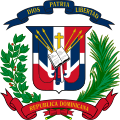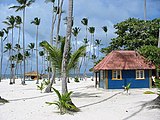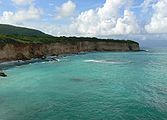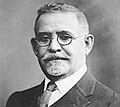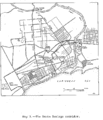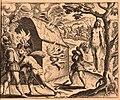Introduction
The Dominican Republic is a country on the island of Hispaniola in the Greater Antilles archipelago of the Caribbean Sea, bordered by the Atlantic Ocean to the north. It occupies the eastern five-eighths of the island, which it shares with Haiti, making Hispaniola one of only two Caribbean islands, along with Saint Martin, that is shared by two sovereign states. It is the second-largest nation in the Antilles by area (after Cuba) at 48,671 square kilometers (18,792 sq mi), and second-largest by population, with approximately 11.4 million people in 2024, of whom approximately 3.6 million live in the metropolitan area of Santo Domingo, the capital city. The Dominican Republic has the largest economy (according to the U.S. State Department and the World Bank) in the Caribbean and Central American region and is the seventh-largest economy in Latin America. Over the last 25 years, the Dominican Republic has had the fastest-growing economy in the Western Hemisphere – with an average real GDP growth rate of 5.3% between 1992 and 2018. GDP growth in 2014 and 2015 reached 7.3 and 7.0%, respectively, the highest in the Western Hemisphere. Recent growth has been driven by construction, manufacturing, tourism, and mining. The country is the site of the third largest (in terms of production) gold mine in the world, the Pueblo Viejo mine. The Dominican Republic is the most visited destination in the Caribbean. The year-round golf courses and resorts are major attractions. A geographically diverse nation, the Dominican Republic is home to both the Caribbean's tallest mountain peak, Pico Duarte, and the Caribbean's largest lake and lowest point, Lake Enriquillo. The island has an average temperature of 26 °C (78.8 °F) and great climatic and biological diversity. The country is also the site of the first cathedral, castle, monastery, and fortress built in the Americas, located in Santo Domingo's Colonial Zone, a World Heritage Site. (Full article...) Selected article -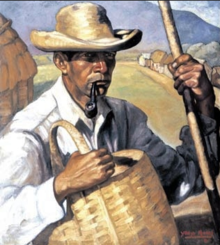 Dominican art comprises all the visual arts and plastic arts made in Dominican Republic. Since ancient times, various groups have inhabited the island of Ayíti/Quisqueya (the indigenous names of the island), or Hispaniola (what the Spanish named the island); the history of its art is generally compartmentalized in the same three periods throughout Dominican history: pre-Hispanic or aboriginal Amerindian (500 BC to 1500 AD), Hispanic or colonial (1502 to 1821 AD), and the national or Dominican period (1844 to present day). Archeological evidence for human populations on the island go back to around 6,000 years ago, when Archaic Age foragers arrived from South America to the Caribbean island. Going back to the origins of autochthonous art, corresponding to the stage known as prehistoric, primitive or pre-Hispanic, we find several ethnic groups that made up the aboriginal culture: Tainos, Igneris, Ciboneyes, Kalinago and Guanahatabeyes. Of all of them, Taino art was the majority and most widespread throughout the insular territory, leaving behind an abundance of pottery and ceramic structures. (Full article...)General images -The following are images from various Dominican Republic-related articles on Wikipedia.
Selected picture -Caribbean flamingos in Lago de Oviedo at Jaragua National Park
Selected biography -Junot Díaz (/ˈdʒuːnoʊ/; born December 31, 1968) is a Dominican-American writer, creative writing professor at Massachusetts Institute of Technology, and a former fiction editor at Boston Review. He also serves on the board of advisers for Freedom University, a volunteer organization in Georgia that provides post-secondary instruction to undocumented immigrants. Central to Díaz's work is the immigrant experience, particularly the Latino immigrant experience. Born in Santo Domingo, Dominican Republic, Díaz migrated with his family to New Jersey when he was six years old. He earned a Bachelor of Arts degree from Rutgers University, and shortly after graduating created the character "Yunior", who served as narrator of several of his later books. After obtaining his MFA from Cornell University, Díaz published his first book, the 1995 short story collection Drown. (Full article...)Related portalsWikiProjects
Things to do
Associated WikimediaThe following Wikimedia Foundation sister projects provide more on this subject:
SourcesDiscover Wikipedia using portals | |||||||||||||||||||||||||
